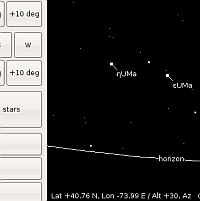In the long list of use cases you've thought of for One Laptop Per Child, did planetarium software ever occur to you as the killer application for the Children's Machine XO? Yeah, me neither.
But then again, we're not David W Hogg, we didn't develop OLPC Planetarium, and we didn't realize that:
The OLPC is the best platform ever devised for electronic support of by-eye astronomical observing.Now that we know the OLPC XO technology rocks (Was that ever in doubt?), David educates us on why planetarium software, vs. say an electronic Library of Alexandria, is the ultimate third-party educational software for children's schooling:It is a low power device that can be mechanically powered by the user; it has a reflected-light mode in which it does not contribute to local illumination (so the observer can read the display with a red flashlight and it won't compromise dark adaptation), and it is light and rugged.
Planetarium software is, in many ways, the killer app for the OLPC. It provides support for the real-world and zero-cost educational activity of observing the sky at night, but it also provides a fun activity center for students to explore the behavior of the night sky and the stars and planets it contains. Many important educational activities can be built around (or discovered within) a rich planetarium software environment.Hmm... While I might disagree that its the killer app, OLPC Planetarium does look promising. If I were a parent, I'd love to take my child out for a night of stargazing with a reliable guide to the millions of stars.
David's dream software does need a bit of work. He's asked for screen resolution advice on the OLPC developer listserv and he is willing to share alpha versions in exchange for constructive feedback.
If I may be so bold, I would suggest he look into an automatic location orientation process. Currently it seems that users would need to enter their latitude manually, which may be difficult for children and their teachers to do. Test his process out yourself:
Imagine where Polaris would be in the sky if you lived at the North Pole. Now set your latitude to +90 deg N and check. Do the same for the equator (latitude 0 deg N). How does the Sun move in the sky in December when you are at latitude +77 deg N?Still, the idea is interesting and its sure to create untold number of new astronomers craning their neck to get a glimpse of the heavens, explained.



As an amateur astronomer I've often stressed to parents the importance of learning about the night sky and indeed where we exist in the Universe.
Many planetarium programs I've used in the past have needed a lot of processing power to render the night sky in detail. This program seems to provide the right balance of detail and resource usage. In most cases naked eye observation needs minimal detail as the eye has difficulty observing dim objects.
As far as calculating your location and time, locations within a few degrees should be close enough for most observations. Many planetarium programs offer a list of locations that a user can choose as their location. Observation time is probably more important and sometimes more difficult to determine. I'd love to see an option to enter when the sun sets and calculate local time from the observation itself.
Congratulations to David Hogg for a well made program.
I agree that the location has to be simply determined by a lookup table. E.g. one can ask the user "What is the larges nearby city?" and should be able to be within a few degrees with a relatively small table of geographic locations.
As for the time, for all I know the OLPC has a real time clock and since it is networked, it can tap into the network time servers once in a while and keep its clock just as accurate as any other computer.
For a casual observer a time error of a few minutes for astronomical observations is most likely of no importance.
My deeper question would be if it is within the realm of the OLPC environment to tap into astronomy resources like the planetary data base at NASA, the Sloan Digital Sky Survey etc. and act as something like an illustrated astronomy textbook?
Haven't looked at it yet, but as regards location, the xo comes with a world atlas pre-installed. So give the kids a simple line drawing of the world and let them mark an x where they think they are.